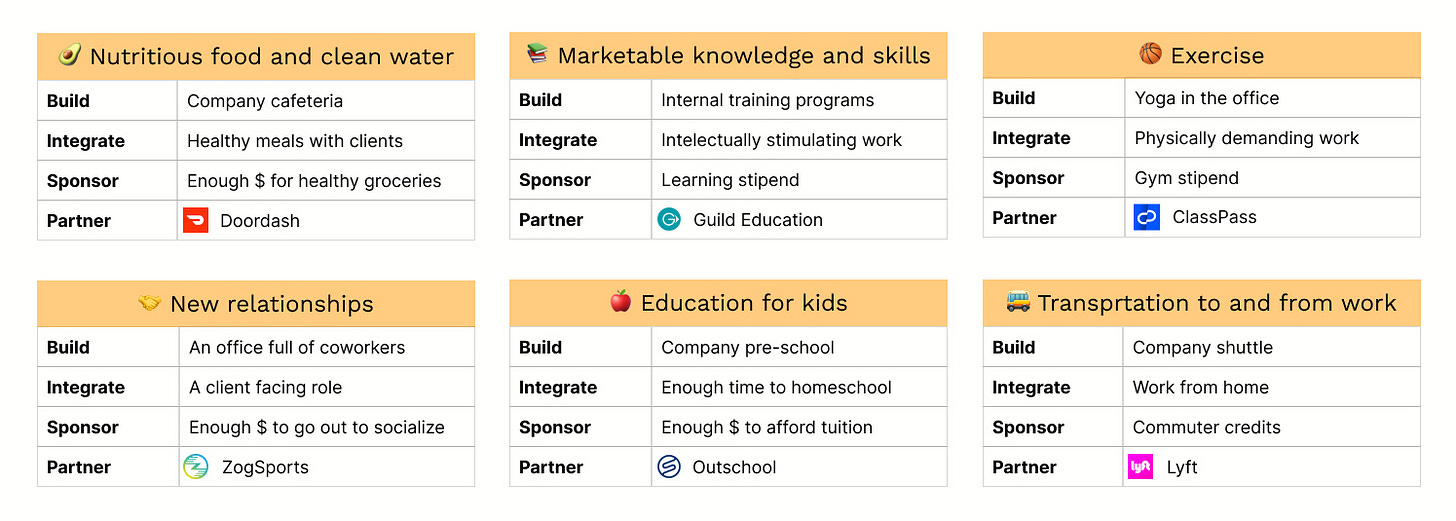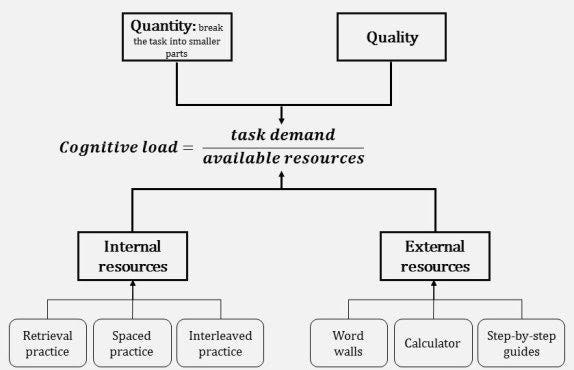The Jungle Gym is a newsletter to help you think clearer and work smarter.
👋 If you're new here, check out this introductory post to learn what this newsletter is all about.
💬 For more frequent updates on what I'm reading and thinking about, visit me on Twitter.
📝 And, if you aren't yet a subscriber and want to sign up for future issues, enter your email here:
The Rundown
Here's the quick rundown on what this issue of The Roundup will cover:
Featured Essay
☀️The Minimum Viable Good Life – Can we design a future of work that promotes human flourishing?
Recommendations & Riffs
🏝 Whether remote work is worth it
👬 Building a life with your squad
🧠 Using cognitive load theory to be more effective at work
⏱ The formula for delegation
👑 Navigating power and status in the office
🤫 The function of lying in entrepreneurship
But first, a couple of quick updates…
New Format Name – To differentiate this type of email from The Keyring, I'm now calling this format: The Roundup. Same basic structure. New name.
Community Hub – Since the first issue of the Jungle Gym, this newsletter has featured a Community section where I give shoutouts to readers who've done impressive things. In issues past, this section took up a lot of real estate, constraining my ability to include other content in these emails. To fix this, I've built a new community hub for The Jungle Gym. At the moment, you'll be able to find:
Shoutouts about impressive things other readers have been doing and publishing
Recommendations for newsletters and blogs published by other readers
My Favorite Books
I plan to keep improving this page over time, so if you have ideas on making it better, shoot me a reply or leave a comment.
The Minimum Viable Good Life
Let me tell you a story about the future of work.
You wake up on a Monday in September. After fixing yourself a cup of tea, you step out your back door and make your way into the woods. After a few hundred yards, you come upon a wooden structure with one wall made of glass.
You slip inside and sit down at your desk. Like always, the first few hours of the day are yours to focus on whatever's most important.
As you dive into your work, there are no pings, bings, or buzzes.
No calendar appointments.
No Slack messages.
No emails.
This time is entirely yours; co-workers appreciate how important mornings are for uninterrupted focus.
A few hours later, you head back to the house where your spouse is serving lunch. You sit down at the picnic table beside your two kids, across from another family who lives in the house next door. You help yourself to some salad. The veggies are fresher than anything you used to eat when you lived in the city.
After cleaning up lunch, everyone puts on running clothes and heads off for a quick jog through the woods. As you arrive at the lake, everyone stops to take a quick cold plunge. When you return home, the kids return to their schooling pod while the adults head back to work.
You slip back into your office for a collaborative working session with two junior designers on your team. While the output of the project is important to the company, it's been scoped for training, so you're in no rush to submit a deliverable. You run the session like a class, letting them try their hand at the prompt before offering feedback.
You take your last few meetings by phone on a walk through the woods. As you arrive back in your yard, you find your spouse, kids, and three other families sitting around the fire. You help yourself to some dinner and take a seat beside them.
Your spouse breaks out a guitar, and everyone sings along to bad 90s songs until the kids are ready for bed. Not long after you put your kids to sleep, you and your spouse retire to the bedroom for a good night's rest.
A Fulfilling Future of Work
For most of recent history, work constrained how we live. It influenced where we slept, who we spent time with, and how our days were structured. But as work begins to uncouple from location, we have a rare opportunity to reimagine our collective future.
What if this time around, instead of planning our lives around work, we designed work to help us lead more fulfilling lives?
To explore this question, we will need to construct a shared templater for a fulfilling life. While the definition of a good life is a heavily debated topic across many academic fields, that doesn't mean we should feel too intimidated to weigh in.
What follows are 18 elements that I believe are necessary to allow people to build satisfying and prosperous lives. This list isn't meant to be comprehensive of everything a person might want. There's no Tesla. No trip to Tulum. No iPhone 12. Rather, once all the needs below are filled, most people should have the resources to build a life they want. For simplicity's sake, let's call this set of 18 elements: The Minimum Viable Good Life (The MVGL).
Delivering the Good Life
Perhaps you're wondering whether employers can and should offer all these things as benefits to their employees.
I wouldn't recommend it.
However, employers should take an interest in ensuring their employees can check the boxes of the MVGL. Why?
The output workers create drives the revenue that keeps their companies alive and growing. Since workers' outputs are a function of their inputs, employers should want to ensure their workers to get what they need to perform at a high level.
To deliver the elements of the MVGL to their employees, companies can use several strategies, including:
Building shared resources at a company level.
Integrating them into the day to day responsibilities of job roles
Sponsoring employees to acquire them on their own (by increasing compensation)
Partnering with another organization to provide them
It's possible to take different approaches to each element. For example, take my employer, Guild (we're hiring!):
Guild built a daycare solution for its workers.
Due to the company's mission, Guild has been able to integrate the chance to pursue meaning within employees' job responsibilities.
Guild sponsors exercise by offering a monthly stipend.
The company partners with Modern Health to deliver mental health services.
The following tables show how a company could employ any of these strategies to help fulfill different elements of the MVGL:
Let's Get Prescriptive
With that context in place, let's explore how companies might integrate the MVGL into their employee experience:
Step 1: Survey your employees
Find out how your people are spending their time. How many minutes each week do they spend exercising? How often do they talk to their five closest friends? Do they worry about debt a lot? This data can offer valuable insight on which needs your employees are and are not able to satisfy.
It's also useful to gather insight into how employees feel about their lives. Are they getting energy from work? What's keeping them up at night? What gets them out of bed in the morning?
Allowing employees to anonymize their answers will drive up participation. But, ideally, you'll want to perform follow up interviews to understand the root causes of the challenges employees are facing.
Step 2: Prioritize areas to address
Using the aggregated survey results, rank each area of the MVGL on the following dimensions:
Fulfillment – which elements of the MVGL is your workforce having the most trouble satisfying?
Sentiment – which unsatisfied needs are creating the largest negative impact on employees' lives? Which ones, if solved, would make the biggest positive impact?
Brand Risk – which needs, if left unfilled, are most embarrassing for the company (for example, it would be embarrassing for the press to learn that the employees of a health food company don't have access to nutritious food)
Step 3: Brainstorm high leverage interventions
Some interventions can satisfy multiple needs at once.
For example, transitioning employees to remote work can give them the flexibility to:
Invest in relationships with family members
Get the sleep they need
Shop for and cook nutritious meals
Offering employees an across-the-board-raise can help them afford:
Better education for their kids
Care for their aging relatives
A safer and quieter place to sleep and work
As you're brainstorming interventions, think back to the four strategies that companies can use to fulfill the elements of the MVGL.
Step 4: Prototype and test solutions with small groups of employees
Before rolling interventions out to the entire company, test them on smaller groups of employees. Ideally, look for groups who desperately want to solve the problem that your intervention is designed for, as they'll be more forgiving about initial road bumps.
The interventions you choose to test should specifically fit the needs of those in your ideal employee profile. For example, if it's mission-critical for your company to attract and maintain a larger junior salesforce, you may want to prioritize interventions that allow your employees to socialize and build bonds with one another. If your most valuable employees tend to be older and have families, you may want to focus on interventions that give employees maximum flexibility to serve as caretakers.
A Conversation Starter
There are, of course, lots of questions that remain unanswered, including:
How can we ensure that people aren't entirely dependent on their employers to fill all these needs?
Which parts of the MVGL should we depend on the government to deliver?
How can small businesses that can't afford to offer the full MVGL still support their workers?
This essay doesn't offer all the answers. But I hope it will inspire some useful conversations between HR departments and their employees about ways to partner and create a better future of work.
Back to the Future of Work
As you lay your head on the pillow, after kissing your spouse good night, you take a moment for gratitude. Who'd have ever thought you'd find work that enabled you to raise your kids in such a tight-knit community or nourish your body with food grown in your own backyard?
While life isn't perfect, you feel so much more authorship of it. Thinking back to the way you used to live, all those years ago, you can't help but appreciate your work and the life it's enabled you to live.
Thanks to the folks at Compound like Dan, Drew, Patrick, Rob, and Tom for their thoughtful edits. As well as Ashley and Justin, for their valuable feedback.
Recommendations & Riffs
😕 Our remote work future is going to suck
(13-minute read by Sean Blanda)
Despite the vision I painted in the previous essay, you may be surprised to learn that I'm no fan of remote work. Collaborating through Slack and Zoom all day leaves me feeling drained and isolated. Without the context of body language, I often sense I'm missing cues about what my colleagues are thinking and feeling.
Creative work is particularly challenging. In a traditional office, you can pull your colleagues into a room for a couple of hours and jam on a whiteboard. But with remote work, there's no easy way to do that.
Yet, despite these drawbacks, I can't help but love the life that being remote enables. Working from home has given me time to nourish my body with healthy home-cooked meals. It's changed how my wife and I relate to one another. The flexibility has even allowed us to co-work with close friends in other parts of the country. While I miss impromptu whiteboard sessions and coffee with co-workers, I'm not sure I could fully return to the way I used to work.
💰 Squad Wealth
(9-minute read from Sam Hart, Toby Shorin, Laura Lotti)
Back in early February, I wrote about a few trends I was paying attention to. One that got a lot of interest from readers was the idea of new living arrangements to facilitate lasting friendships.
As remote work adoption has accelerated, the challenges of living with friends feel more solvable than ever. Assuming the remote work trend continues, groups of friends will be able to cohabitate in inexpensive parts of the country without giving up their jobs.
As squads build lives together, it will be interesting to see what other solutions spring up to help them operate. Will there be a social network that favors squad profiles over individuals? What about the infrastructure that keeps track of contributions to the group?
One of the most interesting ideas from this post is how and whether squads might pool income or attempt to build wealth as a group. There are obviously many challenging social dynamics that come from disparate contribution levels, but I'm excited to see some experiments take flight.
🧠 Simplifying Cognitive Load Theory
(5-minute read from Adam Boxer)
Cognitive Load Theory (CLT) has been described by education expert Dylan Wiliam as "the single most important thing for teachers to know."
The theory is built on two main ideas:
There's a limit to how much new information the human brain can process at one time.
There are no known limits to how much stored information can be processed at one time.
Even if you aren't a teacher yourself, parts of your job almost certainly require you to teach others new things. For example:
Designers need to help customers learn to use new products and features.
HR teams must ensure new employees are properly onboarded.
Managers have to delegate new tasks to their direct reports.
For those that want a quick primer on how to improve communication to optimize for cognitive load, this article is a place to start. The post covers interventions, including practice methods, knowledge representation structures, and tools that can increase learners' available resources and reduce task demands.
If you seek to become a better communicator and people manager, cognitive load is a useful mental model to add to your toolbelt.
🤝 360 Delegation
(5-minute read by Timothy Francis)
Talented individual contributors often fall into a trap when progressing into management.
After recognizing they can no longer do everything themselves, new managers attempt to delegate the tasks they once performed to their direct reports. Because they can't remember what it was like to be a novice, they don't give their direct reports specific enough instructions.
A week later, they check on the progress of the task only to find that it hasn't been completed the way they wanted. In exasperation, they re-claim the responsibility assuming that they are the only ones who can do it correctly.
Unfortunately, these managers rarely lead successful teams because they can't get the leverage that real leaders need.
360 Delegation is a great and simple method for delegating responsibilities to free up time. Here's how it works:
👑 Navigating Power & Status
(17-minute read by Tom Critchlow)
When starting a new job, you'll need to quickly develop a theory for how to get things done at your new company. While org charts and formal orientations provide some clues, they rarely document the critical power and status relationships within an organization.
Consultants, like Tom, must be particularly good at quickly understanding the social dynamics of an organization to achieve their mandates. He believes there are three types of people who hold power within an organization:
Decision-makers – Subject matter experts who need to be consulted on decisions or maintain the implicit permission to make decisions themselves.
Gatekeepers – Those who control access to time (e.g., executive assistants) and information (e.g., data scientists)
Makers – Those who can combine rare skillsets to produce valuable assets
Tom's universal rule for spotting power nodes: look for who gets brought into the room.
When an executive stops the meeting to demand someone else should be in the room - that’s a sign of significant power. When a conversation constantly references someone’s name (e.g. an exec assistant) that’s a sign of significant power.
🤫 Are Founders Allowed to Lie?
(11-minute read by Alex Danco)
I've long-held a rather unpopular take on Theranos CEO, Elizabeth Holmes, that I usually only bring up when I'm a few vodka sodas deep.
Basically, I think she wasn't that much more immoral than other world-changing founders. The main difference was that her reality distortion field didn't turn out to be very good at manifesting her distortions.
Yes, I recognize health care fraud has much more serious consequences than fraud in other industries, but hey, don't cancel sober Nick for tipsy Nick's lousy take.
Anyway, I was reading Alex Danco's latest post about the social dynamics of lying in Silicon Valley, which expressed my underlying point in a much better way than tipsy Nick has yet been able to manage:
“What’s important in Silicon Valley isn’t quite what’s true right now. It’s a different kind of truth; less about factual truth and more about authenticity. That’s why the blessing that VCs grant founders is so important: it’s a power, but also an acknowledgement of the burden of authenticity that founders have to carry.
It’s not so different from the Kayfabe bargain between pro wrestlers and the crowd. Founders will present you with something pre-true, under the total insistence that it’s really true; and in exchange, everyone around them will experience the genuine emotion necessary to make the project real. Neither party acknowledges the bargain, or else the magic is ruined.”
If Holmes had been able to manifest her lie into reality, she'd still be on every magazine cover. But she couldn't, and thus an example had to be made of her. She may have done something immoral, but if reality had been able to back up her story, we all probably would have let her off the hook.
Community
As I mentioned above, here's the new and improved Jungle Gym Community Hub.
I'd love to hear what you think!
If you found this issue of the newsletter valuable, I'd really appreciate it if you could forward it to a friend, family member, or colleague who you think might enjoy it.
Or, if you'd like to share it on one of your social networks, that would be great as well.
Until next time,












